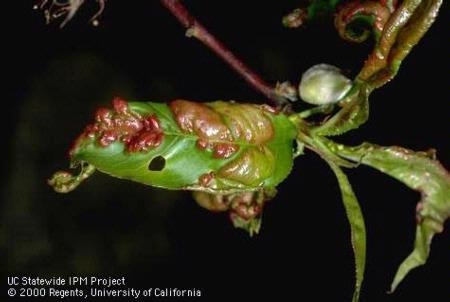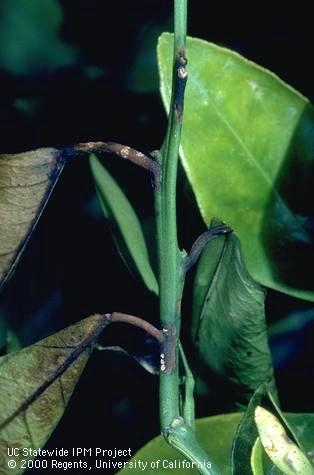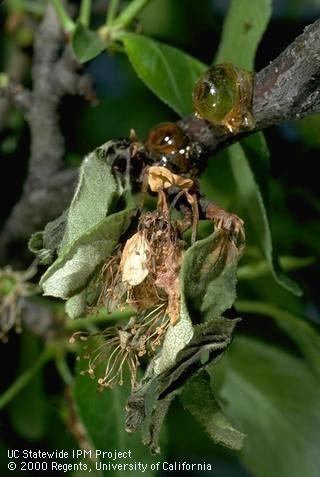By Brent McGhie, Butte County Master Gardener, November 13, 2015

Peach leaf curl is a fungal disease affecting only peaches and nectarines. Its distinctive symptoms include the curling, reddening, and thickening of leaves as they open in the spring. Diseased leaves will die and fall off, but are usually replaced by new, healthy leaves once the weather becomes warmer and drier. Still, if this disease is left untreated, defoliation can lead to sunburned limbs followed by borer attacks. Over several years, affected trees may decline and fruit production can be reduced.
To prevent peach leaf curl, trees must be sprayed with a fungicide after their leaves have dropped and they are dormant. This is usually in late November, or December. If it is a particularly wet winter, a second application of fungicide can be made in early spring, just as buds begin to swell. An easy way to remember is to target spraying for “curly leaf” at Thanksgiving and again at Dr. Martin Luther King's Birthday. Once peach leaf curl symptoms appear (when trees leaf out in the spring) it's too late for anything to be done to stop the disease. Spraying after symptoms show up is ineffective and removing diseased leaves or shoots will not remedy the problem.
For the home gardener, there are two treatment options. The most effective is the fungicide chlorothalonil (commercially sold as Daconil, Fung-onil, and Ortho Garden Disease Control, among other brands). However, it must be handled with care because it is listed as a likely carcinogen and can cause skin and eye irritation if handled improperly or if protective clothing and equipment (gloves and goggles) aren't worn. A somewhat less effective treatment is copper ammonium complex sold as Liqui-Cop (a Monterey Lawn and Garden product), or Kop R Spray Concentrate (a Lilly Miller brand). It can be made more effective by applying it with 1% horticultural spray oil in the spray solution. As is the case with all garden chemicals, be certain to read and follow all cautions and instructions on the label.
If you prefer not to spray, you can avoid leaf curl by planting resistant varieties of peaches and nectarines. Resistant peach varieties include Frost, Indian Free, Muir and Q-1-8. Although the Frost peach variety is very resistant to leaf curl, it must receive fungicide applications in its first two to three years of growth. Kreibich is a nectarine variety that is resistant to leaf curl.

Citrus blast and brown rot are diseases that attack citrus trees. Although citrus blast is caused by a bacterium that attacks leaves and shoots and brown rot is a fungal disease that causes fruit to rot and turn brown, both of these diseases can be controlled by spraying with the same copper ammonium complex used to treat peach leaf curl.
When heavy rain, high winds and low temperatures occur together, conditions are optimal for citrus blast, especially on the windward side of the tree. Leaves affected by this disease have a withered, bleached appearance, as if “blasted” by a blow torch. Diseased leaves and twigs will die and occasionally a larger branch can die back. In most cases, fruit production is reduced and the appearance of the tree is adversely affected.
As with peach leaf curl, once the symptoms of brown rot or citrus blast appear, it's too late to treat them. Both of these diseases are associated with cool, wet conditions, so the best time to spray is before the winter rains begin if you wish to protect navel oranges from brown rot, usually mid-October. A second spraying in mid-December and a third in mid-January has been shown to be effective in reducing the severity of citrus blast. For maximum protection, all parts of the tree should be thoroughly coated. The rough texture of mandarin skins can make it difficult to wash spray residue off of fruit. If this residue is not acceptable, an option is to delay spraying until immediately after fruit has been harvested.
